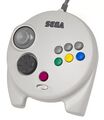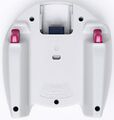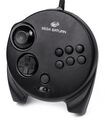Difference between revisions of "3D Control Pad"
From Sega Retro
m (moved Saturn Analog gamepad to 3D Control Pad: official name) |
|||
| Line 1: | Line 1: | ||
| − | {{stub}} | + | {{stub}}{{AccessoryBob |
| − | + | | accessoryimage=AnalogPad.jpg | |
| − | + | | imgwidth=320px | |
| − | + | | title= | |
| − | The '''[[Sega Saturn]] | + | | maker=[[Sega]] |
| − | + | | madefor=[[Sega Saturn]] | |
| − | + | | alsoworks= | |
| − | + | | europe=September 1996 | |
| − | + | | usa=August 31, 1996 | |
| + | | japan=July 5, 1996 | ||
| + | | australia= | ||
| + | | benelux= | ||
| + | | brazil= | ||
| + | | germany= | ||
| + | | scandinavia= | ||
| + | | southkorea= | ||
| + | | rrp_jp= | ||
| + | }} | ||
| + | The '''3D Control Pad''' is a control pad developed for use with the [[Sega Saturn]]. Debuting with ''[[NiGHTS into Dreams]]'', it was [[Sega]]'s answer to the then revolutionary Nintendo 64 controller, which featured an analogue stick as opposed to relying solely on D-Pads. Analogue sticks generally allow for greater precision in a 3D environment, and unlike previous generations, by the time this controller debuted in 1996 3D was seen as the way forward for large parts of the gaming industry. | ||
| + | The 3D Control Pad builds on the features already seen in the standard [[Control Pad (Saturn)|Saturn Control Pad]], containing an eight-direcional D-Pad and {{A}}, {{B}}, {{C}}, {{X}}, {{Y}}, {{Z}} and {{Start}} buttons. New to the controller was an analogue thumbstick (or "3D Directional Pad" as Sega called it), positioned on the left hand side of the controller above the D-Pad. | ||
[[Image:Icon-3dcontrolpadmark.png|thumb|left|200px|US Games that supported the 3D Control Pad has this icon indicating compatibility on the back of the box.]] | [[Image:Icon-3dcontrolpadmark.png|thumb|left|200px|US Games that supported the 3D Control Pad has this icon indicating compatibility on the back of the box.]] | ||
| − | + | To avoid compatibility issues, the analog controller has a switch under the start button to swap between "Digital" and "Analogue" modes. Switching to "Digital" mode disables all analogue settings, essentially turning the controller back into a standard control pad. This switch was vital, because earlier games were not built to understand the analogue technology and will not function correctly if the wrong mode is chosen. The original PlayStation and its latter dual-analogue controllers also required this feature. | |
| + | The 3D Control Pad is not just notable for its analogue stick. Also inlcuded are analogue {{L}} and {{R}} shoulder triggers, the first system to contain these. The controller lead can also be removed from the controller for storage purposes. | ||
| − | + | The 3D Control Pad did not see widespread adoption for the same reason the Sega Saturn failed to capture a large share of the market in the west. The Saturn's 3D output was low, and as the controllers were never bundled with the console, consumers were more familiar with the standard Saturn control pads. It also has some design issues, namely the fact it is quite a lot bigger than most other controllers and arguably less comfortable than the standard pads for certain genres. | |
| − | + | However, the 3D Control Pad can be credited for many common features seen in controllers today. Its design greatly influenced that of the [[Controller (Dreamcast)|Sega Dreamcast Controller]]. Analogue shoulder buttons have since been adopted by both [[Nintendo]] and [[Microsoft]] in the [[Nintendo GameCube]], [[Microsoft Xbox]] and [[Microsoft Xbox 360]]. Likewise, the idea of having the analogue stick positioned on the left hand side above the D-Pad has been adopted by both companies. | |
==Gallery== | ==Gallery== | ||
Revision as of 09:51, 24 January 2011
This short article is in need of work. You can help Sega Retro by adding to it.
| 320x240px |
| 3D Control Pad |
|---|
| Made for: Sega Saturn |
| Manufacturer: Sega |
The 3D Control Pad is a control pad developed for use with the Sega Saturn. Debuting with NiGHTS into Dreams, it was Sega's answer to the then revolutionary Nintendo 64 controller, which featured an analogue stick as opposed to relying solely on D-Pads. Analogue sticks generally allow for greater precision in a 3D environment, and unlike previous generations, by the time this controller debuted in 1996 3D was seen as the way forward for large parts of the gaming industry.
The 3D Control Pad builds on the features already seen in the standard Saturn Control Pad, containing an eight-direcional D-Pad and ![]() ,
, ![]() ,
, ![]() ,
, ![]() ,
, ![]() ,
, ![]() and START buttons. New to the controller was an analogue thumbstick (or "3D Directional Pad" as Sega called it), positioned on the left hand side of the controller above the D-Pad.
and START buttons. New to the controller was an analogue thumbstick (or "3D Directional Pad" as Sega called it), positioned on the left hand side of the controller above the D-Pad.
To avoid compatibility issues, the analog controller has a switch under the start button to swap between "Digital" and "Analogue" modes. Switching to "Digital" mode disables all analogue settings, essentially turning the controller back into a standard control pad. This switch was vital, because earlier games were not built to understand the analogue technology and will not function correctly if the wrong mode is chosen. The original PlayStation and its latter dual-analogue controllers also required this feature.
The 3D Control Pad is not just notable for its analogue stick. Also inlcuded are analogue ![]() and
and ![]() shoulder triggers, the first system to contain these. The controller lead can also be removed from the controller for storage purposes.
shoulder triggers, the first system to contain these. The controller lead can also be removed from the controller for storage purposes.
The 3D Control Pad did not see widespread adoption for the same reason the Sega Saturn failed to capture a large share of the market in the west. The Saturn's 3D output was low, and as the controllers were never bundled with the console, consumers were more familiar with the standard Saturn control pads. It also has some design issues, namely the fact it is quite a lot bigger than most other controllers and arguably less comfortable than the standard pads for certain genres.
However, the 3D Control Pad can be credited for many common features seen in controllers today. Its design greatly influenced that of the Sega Dreamcast Controller. Analogue shoulder buttons have since been adopted by both Nintendo and Microsoft in the Nintendo GameCube, Microsoft Xbox and Microsoft Xbox 360. Likewise, the idea of having the analogue stick positioned on the left hand side above the D-Pad has been adopted by both companies.
Gallery
Physical Scans
JP NiGHTS into Dreams bundle (front)
US NiGHTS into Dreams bundle (front)
US NiGHTS into Dreams bundle (back)
EU NiGHTS into Dreams bundle (front)
US Manual
- 3dpad-1.jpg
Front Side
- 3dpad-2.jpg
Back Side










